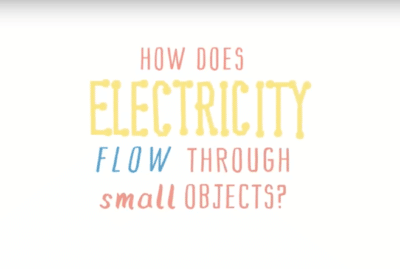Soluble Semiconductors- A revolution in Printing for the 21st Century?
Thursday 22nd Nov 2018, 11.44am
The digital age is built upon semiconductors. The crystalline semiconductors, such as silicon or germanium, lie behind modern electronics and computing. They are such essential materials because their conducting properties may be altered in useful ways by the deliberate, controlled introduction of impurities (“doping”) into their crystal structure to create the components that enable the operation of your mobile phone or even washing machine.
Functional Inks
The processes used to produce traditional semiconductors require very thin sections of crystals that are energy-intensive and difficult to produce. They are also ill suited to large area structures such as displays or solar panels and generally require expensive fabrication facilities.
This creates an opportunity for a different approach. Soluble semiconductors, by contrast, are prepared as functional inks by being dissolved in a liquid, which can then be deposited via coating or printing at or near room temperature onto a wide variety of different surface types and shapes. Their low temperature processing enables the use of flexible plastic substrates and facilitates a reduction in energy consumption.
Using ink-jet printing techniques
Soluble semiconductors are already driving exciting advances in many of the technologies we interact with on a daily basis, including displays, lighting, electronics, solar panels and sensors. This fast-evolving area is opening new paradigms for device fabrication, especially for large-area, transparent and/or flexible devices, allowing us to experience otherwise taken-for-granted functions through intriguing new formats.
By switching to soluble semiconductors there is an opportunity to use fabrication methods akin to printing newspapers, known as roll-to-roll printing. Large rolls of material run through rollers where functional inks can be printed over large areas and in successive layers to build up devices. Such approaches are expected to produce economies of scale, reducing the cost of expensive items such as solar panels and helping to open the possibility for many novel applications.
Conventional fabrication versus Printing or Coating
| Conventional | Printing |
| High temperature and controlled environment for growth | Processed at or near room temperature |
| Components are cut or formed from a larger block, creating waste |
Additive continuous process Materials printed/coated only where needed |
| Higher equipment and materials cost | Lower equipment and materials cost |
Potential Applications
Soluble semiconductors have a wide range of applications especially where large areas and/or mechanical flexibility/stretch-ability are desirable characteristics.
Displays
Displays that are capable of rolling up and folding would provide an immense new market for personal electronics. Being able to carry a large display to connect to your mobile device would transform the way people use their mobile phones and tablets. The first steps in that direction have been taken by the recent commercialisation of ink-jet-printed, high resolution displays.
Click here to read more about displays
Lighting
Flexible lighting panels that can be applied to any surface can provide great versatility as well as room for the design of specialised lighting units with both decorative and functional uses. Solution processing is the only viable approach to reach the target cost points required for lighting applications.
Click here to read more about lighting
Photovoltaics
Solar panels that can be mounted on surfaces that aren’t flat offer many advantages over today’s heavy and rigid installations. Soluble semiconductors allow photovoltaics to be applied directly to building surfaces or incorporated in construction products such as facades and, potentially, roof tiles. Semi-transparent panels can also be considered for use directly within the windows of modern skyscrapers. Such products have recently made it into the market.
Click here to read about these photovoltaic products
Sensors
Sensors incorporated in fabrics and clothes can change the way health monitoring and athletic training is undertaken. Simple diagnostic devices that are user-friendly offer quantitative, point-of-care formats suited to both rapid assessment and long term monitoring.
Click here to read about sensors
Some Current Challenges
Encapsulation
Many materials are sensitive to oxygen and water exposure, which can significantly degrade their function and performance. Low cost encapsulation methods that can provide a sufficient barrier to external influences need to be achieved in order to enhance device lifetime. Ink-jet printed materials are being developed for this purpose.
Click here to read about ink-jet materials
Functional materials
In order to make devices entirely using soluble materials, all of the layers found in a conventional device should have soluble equivalents, including the semiconductors, metals and insulators. Developing high quality soluble materials to deliver these functions, which can also be readily processed from safe solvents, is an ongoing challenge.
Device Performance
Not all applications are well suited to the use of soluble semiconductors, for instance the high performance required for computer processors cannot be achieved. As a consequence hybrid integration may be required for certain applications where soluble and traditional semiconductors are married together to provide the best of both worlds
Click here to read about large area electronics
Here at Oxford
Here at Oxford we focus on these challenges and try to find combinations of materials that give the best performance and ease of processing suited for the intended application. We study how light and electricity interact with our materials and how the individual molecules arrange themselves in the device in order to understand the best configuration or to discover new and interesting phenomena which can open up novel applications. For example, we study materials that could form printable ultra-fast diodes, which could harness power from local wifi networks to power cheap sensors for health monitoring or food spoilage. We look at ways of creating novel light emitting diodes and lasers for applications in displays and cheap sensors. We also research how to make solar power cheaper, lighter and more robust so that you can generate power anywhere.
Contact us about the following teaching resources:
KS4: Ohm’s law and Ohmic conductors
KS5: Resistivity and error in measurement
KS5: What is a Semiconductor?






